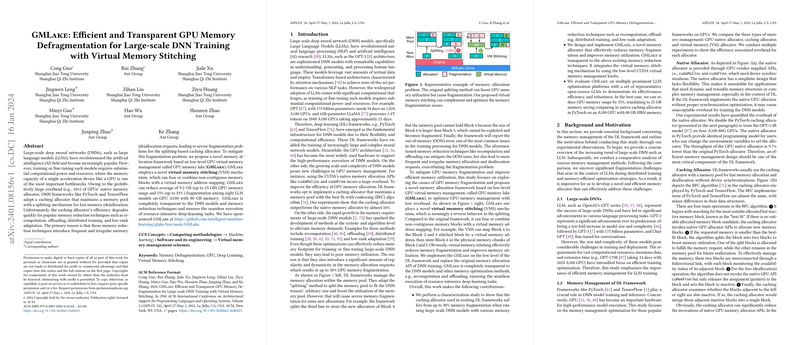Overview of GMLake: Efficient GPU Memory Defragmentation for Large-Scale DNNs
The paper "GMLake: Efficient and Transparent GPU Memory Defragmentation for Large-Scale DNN Training with Virtual Memory Stitching" presents a novel approach to address memory fragmentation in training large-scale deep neural networks (DNNs) on GPUs. The central focus of this research is on the development and implementation of a GPU memory allocation framework named GMLake, which leverages low-level virtual memory management to optimize memory usage during DNN training.
Memory Fragmentation Issues in DNN Training
As DNN models grow in complexity and size, memory fragmentation has emerged as a significant challenge, particularly for LLMs. Memory fragmentation occurs when available memory is inadequately utilized due to uneven allocation and deallocation patterns. This paper identifies the limitations of existing GPU memory management techniques, such as the native memory allocator and caching allocators like those in PyTorch and TensorFlow. Traditional caching allocators often exhibit inefficiencies when dealing with memory reduction techniques like recomputation, offloading, and distributed training, leading to dramatic fragmentation.
GMLake's Innovative Approach
GMLake introduces a unique memory allocation strategy, employing a mechanism called Virtual Memory Stitching (VMS). This mechanism addresses fragmentation by effectively combining non-contiguous memory blocks, mapped through virtual memory addresses. This approach is novel in that it bypasses the need for contiguous physical memory, which is a common constraint in conventional caching allocators. The GMLake allocator works by creating a virtual memory pool, organized into primitive memory pools and stitched memory pools, to facilitate efficient allocation.
Numerical Results and Implications
The empirical evaluations of GMLake demonstrate significant reductions in memory usage and fragmentation across various large-scale models and training configurations. On Nvidia A100 GPUs, the framework shows a reduction in GPU memory usage by an average of 9.2 GB, reaching up to 25 GB, and a decrease in fragmentation by 15%, peaking at 33% across multiple LLMs. These results suggest that GMLake can effectively enhance the execution of resource-intensive DNN tasks without compromising training throughput.
Theoretical and Practical Implications
From a theoretical perspective, GMLake's approach to defragmentation and memory management could pave the way for further research into optimizing existing DL frameworks. By integrating VMS, researchers can explore novel algorithms that capitalize on non-contiguous memory mapping to minimize overhead and maximize resource usage.
Practically, the adoption of GMLake in mainstream deep learning frameworks has the potential to significantly impact how large-scale models are trained, particularly in environments where memory resources are a primary bottleneck. The seamless integration of GMLake promises minimal disruption while offering substantial improvements in memory efficiency.
Future Directions
The insights provided by this research open avenues for further explorations, including adaptation for other hardware accelerators beyond GPUs, such as TPUs or custom ASICs designed for AI workloads. Additionally, the techniques described in GMLake can be extended to offer more granular control over memory allocation, potentially benefiting applications in real-time machine learning systems where predictable memory usage is critical.
In summary, the GMLake framework provides a powerful solution for mitigating memory fragmentation in modern DL frameworks, reinforcing the scalability and sustainability of large-scale DNN deployments. This research is a step forward in optimizing AI infrastructure, ensuring that computational resources are used efficiently and effectively.
